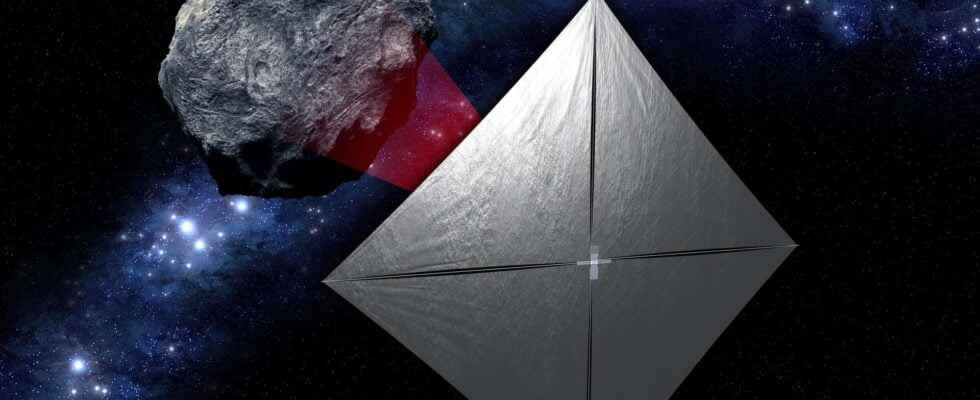On March 12, the first mission of the Artemis lunar program will be launched. The rocket Space Launch System will carry a passenger unknown to the general public: the NEA Scout probe, which will have the task of flying over a near-Earth asteroid.
You will also be interested
[EN VIDÉO] Dart, a suicide mission to deflect an asteroid For planetary defense, the Dart probe will travel to a double asteroid and collide with it in order to measure its impact on its orbit. In video: launch, deployment and progress of the mission.© NASA, Johns Hopkins APL, Steve Gribben, Jessica Tozer
The Artemis I mission will not only serve to test the capabilities of the new rocket Space Launch System (SLS) and the lunar module Orion. The engineers of Jet Propulsion Laboratory (JPL) will take advantage of the launch of Artemis I on March 12, 2022 to integrate a device of their creation, the NEA Scout (for Near Earth Asteroid Scout). This small cubic probe will leave on the SLS launcher and will fly over a asteroid, 2020 GE. NEA Scout is equipped with a camera, giving JPL researchers the ability to image and study in detail the properties of the NEO. The goal is to learn more about these objects that orbit in regions near the Earth, in order to be able to develop strategies if one of these asteroids were to one day threaten the Earth.
NEA Scout: a cube studying near-Earth cruisers
Hard not to doanalogy with the recent release of the film Don’t Look Upthe NEA Scout project emanating from the program Next Space Technologies for Exploration Partnership (NextSTEP, or “partnership for future space exploration technologies”) launched in 2015 by the Nasa. NEA Scout has characteristics that are singular to say the least: rectangular in shape, it is a nano-satellite the size of a large shoebox, which is called a CubeSat. The NEA Scout will be deployed from the SLS after the Orion module of Artemis I detaches from the launcher. the CubeSat will then head to asteroid 2020 GE, traveling through space thanks to a ” solar sail » of 86 square meters in polymer aluminized. If the sail seems excessive, compared to the reduced size of NEA Scout, the objective is to optimize the reflection of photons on this canvas. A phenomenon occurs, radiation pressurewhich causes an impulse necessary for the device to move forward in the vacuum of space.
Its target, 2020 GE, discovered in March 2020is classified as a near-Earth asteroid, orbiting near Earth and periodically crossing theorbit of the planet during its revolution around the Sun. 2020 GE, 18 meters in diameter, will be the smallest asteroid flown over and studied to date. NEA Scout shall image the object using a small camera fitted to the CubeSat. The data provided by the probe will make it possible to determine the composition of the asteroid, namely whether it is made up of a solid block or an aggregate of rocks and celestial dust, like the imposing Benu. NEA Scout will fly over 2020 GE when the latter comes closest to Earth, 5.7 million kilometers away.
2022, the year of the asteroids
Julie Castillo-Rogez, researcher at JPL and one of the project managers, explained in a statement from NASA published on January 20 that “ 2020 GE represented a class of asteroids that we know little about “. The mission undertaken by NEA Scout will also serve to learn more about these types of asteroids in order to invent and adapt strategies to protect the Earth in the event that one of these objects comes to pose a threat.
NEA Scout is part of the US Space Agency’s strategy to strengthen its arsenal to protect the Earth against asteroids. Thus, NASA announced in December 2021 the system algorithmic Sentry II, responsible for constantly monitoring the various objects in orbit near the planet. In November, the Dart probe, responsible for deflecting the asteroid Dimorphos in September 2022, was sent several million kilometers away. On the other hand, it will be necessary to wait until 2023 to see the first images of 2020 GE, which NEA Scout will reach in September of the same year.
Interested in what you just read?
